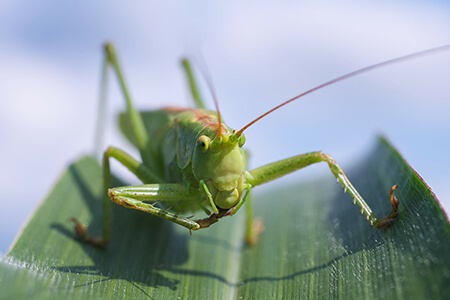This is a lesson summary. The full lesson can be viewed by purchasing an online course subscription.
Learning Objective
In this lesson we will learn about the major invertebrate animal groups.
Learning Outcomes
By the end of this lesson you will be able to:
- Define what an invertebrate is.
- Discuss the defining characteristics of the following invertebrate groups:
- Arthropods
- Molluscs
- Echinoderms
- Annelids
- Nematodes
- Platyhelminthes
- Cnidarians
- Porifera

(Image: realworkhard, Pixabay)
Lesson Summary
- Invertebrates are animals without a backbone.
- Invertebrates may have an exoskeleton, an endoskeleton or no skeleton.
- Major invertebrate groups include:
- Arthropods
- Molluscs
- Echinoderms
- Annelids
- Nematodes
- Platyhelminths
- Cnidarians
- Porifera
- Arthropods:
- Have an exoskeleton made of chitin.
- Have a segmented, bilaterally symmetrical body.
- Have paired, jointed legs; often also have antennae.
- Have an open circulatory system, an excretory system and a nervous system with a primitive brain.
- Arthropods include:
- Insects
- Arachnids
- Crustaceans
- Chilopods
- Diplopods
- Molluscs:
- Have a soft, non-segmented body, usually covered in a hard shell.
- Lack legs, but may have tentacles.
- Have a strong, muscular ‘foot’.
- Have a specialised feeding structure containing teeth.
- Echinoderms:
- Have an internal skeleton made of calcium carbonate.
- Have a soft body, often with spiny ‘skin’.
- Are bilaterally symmetrical in the larval stage and radially symmetrical in the adult stage.
- Have a vascular system that pumps water instead of blood.
- Annelids:
- Have a soft, tubular, bilaterally symmetrical body.
- Have a segmented body, with some repeated organs.
- Have a closed circulatory system.
- Have a specialised digestive system, excretory system and nervous system, including a primitive brain.
- Nematodes:
- Have a soft, tubular, bilaterally symmetrical body.
- Have a non-segmented body.
- Have a complete digestive tract.
- Platyhelminths:
- Have a soft, flat, bilaterally symmetrical body.
- Have a non-segmented body.
- Have an incomplete digestive tract.
- Cnidarians:
- Have a soft, radially symmetrical body, lacking organs.
- Have a single opening for food and waste.
- Have stinging tentacles.
- Porifera:
- Have a spongy, asymmetrical body, lacking tissues and organs.
- Have a body full of pores that allow water to flow through.
- Have an endoskeleton or exoskeleton containing needle-like spicules.
Invertebrate Group Symmetry Segmentation Body Cavity Body Tissues Other Features Arthropods Bilateral Yes Yes Yes Exoskeleton; legs; most insects have wings Molluscs Bilateral No Yes Yes Usually have a hard shell; may have tentacles Echinoderms Radial No Yes Yes Endoskeleton; often spiny Annelids Bilateral Yes Yes Yes Tubular body Nematodes Bilateral No Partial Yes Tubular body Platyhelminths Bilateral No No Yes Flat body Cnidarians Radial No No Yes Stinging tentacles Porifera None No No No Porous, spongy body; spicules
Summary of the invertebrate animal groups
(Header image: maneph9, Pixabay)
